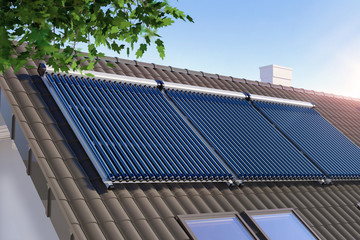
Essentially, there are two various types of solar hot water heater. The first is a stand-alone heater that supplies all the hot water for your house. The second is used as a pre-heater to heat the water entering into your existing hot water heater. The main distinction between the two types is that a stand-alone heating system will usually have a tank to save the heated water and the pre-heater utilizes the existing water heater as a reservoir.
The part of a solar water heater where the water is in fact heated up by the sun is called a heat exchanger. The heat exchanger is the crucial element of the heating system and there are many different designs in use around the globe today.
A stand-alone solar water heater includes a storage tank to save the heated water, the heat exchanger, and the pipes or tubing to link them. In some applications, a one-way valve is set up into the system to prevent the backflow of cold water into the tank, and some systems utilize a small pump to accomplish this and ensure circulation through the heat exchanger.
When a system can be established properly, no pump is essential to achieve blood circulation through your heat exchanger as the natural convective current will do it for free (because hot water is lighter than cold water and will tend to rise to the top pulling cold water into the bottom as it does), however, if your particular application is such that the heat exchange system can not be set on the same level as the storage tank (due to space for the tank and an appropriate location with available sunshine for the heat exchange unit), you might have to use a little pump to guarantee flow through your system. For a genuinely off-grid system, you can utilize a little 12-volt pump and power it with a solar panel. No battery is required due to the fact that the solar heater just works when sunlight is readily available just like the solar panel.
The pre-heater type is tied into the cold water supply line to your existing hot water heater. The method it works is to pre-heat the water coming into your heating unit so it does not have to work as tough as typical and in some cases, not at all. Water that is currently hot does not need as much heating, often none at all. This is an excellent method to save on the part of your energy bill that is used to provide hot water for your house while leaving your existing water heating unit in the system to make sure a supply of hot water on cloudy days or other conditions where your solar water heating unit does not work.
This type of solar water heater includes a heat exchange unit, the lines linking it to the cold water supply, and your hot water heater. A pump is not needed here because the pressure of the inbound water will accomplish the flow through the heat exchanger.
These units work specifically well in the summertime but provision should be made to safeguard the outdoors parts from damage resulting from freezing in the winter. Usually the heat exchanger and lines going to and from your house are the just outdoors parts and can be drained pipes.
These are the two basic types of solar water heater in use all over the world, today. They can be as easy in design as a garden hose depending on the sun, or as complex as you wish to make it with copper or PVC tubing in a sealed box and temperature-activated one-way valves and pumps.
Comments
No comments yet. Be the first to react!